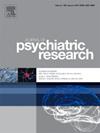Identifying subgroups of adverse childhood experiences (ACEs) in adult general hospital attendees: associations with mental and physical health measures
IF 3.7
2区 医学
Q1 PSYCHIATRY
引用次数: 0
Abstract
Background
Adverse childhood experiences (ACEs) are linked to negative mental and physical health outcomes. While increased ACE exposure often correlates with worse health outcomes, specific combinations of ACEs may heighten the risk for certain conditions and diseases.
Method
Participants (n = 2642) attending inpatient and outpatient departments at an Austrian university hospital provided self-reported measures of physical and mental health, along with retrospective assessments of ACEs. Latent class analysis was utilized to identify subgroups of individuals with co-occurring ACEs. Logistic regression models were employed to investigate the associations between ACE clusters and the prevalence of physical and mental health conditions.
Results
Six classes were identified, with the majority of individuals falling into the ‘minimal ACEs’ class. However, other groups reported specific ACEs such as ‘peer-bullying’, ‘home-neglect’, and ‘physical abuse’, while two groups experienced a variety of ACEs (‘parent abuse and neglect’ and ‘parental and peer bullying’). Classes were differentially associated with the likelihood of reporting specific mental and physical conditions, with higher odds ratios observed in groups endorsing higher ACEs.
Conclusions
This exploratory analysis found that different ACE constellations were associated with varying risks of specific mental and physical health conditions. Identifying individuals within particular ACE clusters could help inform preventive strategies and improve adult health outcomes.
确定综合医院成年住院患者的不良童年经历亚组:与心理和身体健康措施的关联
不良童年经历(ace)与负面的心理和身体健康结果有关。虽然ACE暴露的增加通常与较差的健康结果相关,但ACE的特定组合可能会增加某些条件和疾病的风险。方法奥地利一所大学医院住院和门诊的参与者(n = 2642)提供了自我报告的身体和心理健康指标,并对ace进行了回顾性评估。使用潜在分类分析来确定同时发生ace的个体亚群。采用Logistic回归模型调查ACE集群与身心健康状况患病率之间的关系。结果确定了6个类别,大多数个体属于“最小ace”类别。然而,其他组报告了具体的ace,如“同伴欺凌”、“家庭忽视”和“身体虐待”,而两组经历了各种ace(“父母虐待和忽视”和“父母和同伴欺凌”)。班级与报告特定精神和身体状况的可能性有不同的关联,在支持高ace的组中观察到更高的比值比。结论本探索性分析发现,不同ACE星座与特定心理和身体健康状况的不同风险相关。确定特定ACE集群中的个体可以帮助制定预防策略并改善成人健康结果。
本文章由计算机程序翻译,如有差异,请以英文原文为准。
求助全文
约1分钟内获得全文
求助全文
来源期刊

Journal of psychiatric research
医学-精神病学
CiteScore
7.30
自引率
2.10%
发文量
622
审稿时长
130 days
期刊介绍:
Founded in 1961 to report on the latest work in psychiatry and cognate disciplines, the Journal of Psychiatric Research is dedicated to innovative and timely studies of four important areas of research:
(1) clinical studies of all disciplines relating to psychiatric illness, as well as normal human behaviour, including biochemical, physiological, genetic, environmental, social, psychological and epidemiological factors;
(2) basic studies pertaining to psychiatry in such fields as neuropsychopharmacology, neuroendocrinology, electrophysiology, genetics, experimental psychology and epidemiology;
(3) the growing application of clinical laboratory techniques in psychiatry, including imagery and spectroscopy of the brain, molecular biology and computer sciences;
 求助内容:
求助内容: 应助结果提醒方式:
应助结果提醒方式:


